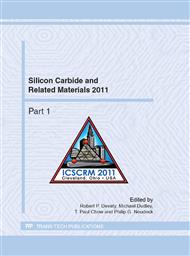[1]
J. Rozen, A. C. Ahyi, X. Zhu, J. R. Williams, L. C. Feldman, Scaling between channel mobility and interface state density in SiC MOSFETs, IEEE Trans. Electron. Dev. 58 (2011) 3808.
DOI: 10.1109/ted.2011.2164800
Google Scholar
[2]
H. Li, S. Dimitrijev, H. B. Harrison, D. Sweatman, Interfacial characteristics of N2O and NO nitrided SiO2 grown on SiC by rapid thermal processing, Appl. Phys. Lett. 70 (1997) 2028.
DOI: 10.1063/1.118773
Google Scholar
[3]
G. Y. Chung, C. C. TiN, J. R. Williams, K. McDonald, R. K. Chanana, R. A. Weller, S. T. Pantelides, L. C. Feldman, Improved inversion mobility for 4H-SiC MOSFETs following high temperature anneals in nitric oxide, IEEE Electron Dev. Lett. 22, (2001) 176-178.
DOI: 10.1109/55.915604
Google Scholar
[4]
M. Noborio, J. Suda, T. Kimoto, Enhanced channel mobility in 4H-SiC MISFETs by utilizing deposited SiN/SiO2 stack gate structures, Mater Sci. Forum 600-603 (2009) 679-682.
DOI: 10.4028/www.scientific.net/msf.600-603.679
Google Scholar
[5]
S. Hino, T. Hatayama, J. Kato, E. Tokumitsu, N. Miura, T. Oomori, High channel mobility 4H-SiC metal-oxide-semiconductor field-effect transistor with low temperature metal-organic chemical-vapor deposition grown Al2O3 gate insulator, Appl. Phys. Lett. 92 (2008) 183503.
DOI: 10.1063/1.2903103
Google Scholar
[6]
D. L. Lichtenwalner, V. Misra, S. Dhar, S.-H. Ryu, A. Agarwal, High-mobility enhancement-mode 4H-SiC lateral field-effect transistors utilizing atomic layer deposited Al2O3 gate dielectric, Appl. Phys. Lett. 95 (2009) 152113.
DOI: 10.1063/1.3251076
Google Scholar
[7]
S. Wang, S. Dhar, S. R. Wang, A. C. Ahyi, A. Franceschetti, J. R. Williams, L. C. Feldman, S. T. Pantelides, Bonding at the SiC-SiO2 interface and the effects of nitrogen and hydrogen, Phys. Rev. Lett. 98 (2007) 026101.
DOI: 10.1103/physrevlett.98.026101
Google Scholar
[8]
T. Hiyoshi and T. Kimoto, Elimination of the major deep levels in n- and p-type 4H-SiC by two-step thermal treatment, Appl. Phys. Expr. 2 (2009) 091101.
DOI: 10.1143/apex.2.091101
Google Scholar
[9]
T. L. Biggerstaff, C. L. Reynolds Jr, T. Zheleva, A. Lelis, D. Habersat, S. Haney, S.-H. Ryu, A. Agarwal, G. Duscher, Relationship between 4H-SiC/SiO2 transition layer thickness and mobility, Appl. Phys. Lett. 95 (2009) 032108.
DOI: 10.1063/1.3144272
Google Scholar
[10]
T. Shirasawa, K. Hayashi, H. Yoshida, S. Mizuno, S. Tanaka, T. Muro, Y. Tamenori, Y. Harada, T. Tokushima, Y. Horikawa, E. Kobayashi, T. Kinoshita, S. Shin, T. Takahashi, Y. Ando, K. Akagi, S. Tsuneyuki, H. Tochihara, Atomic-layer-resolved bandgap structure of an ultrathin oxynitride-silicon film epitaxially grown on 6H-SiC(0001), Phys. Rev. B 79 (2009) 241301(R).
DOI: 10.1103/physrevb.79.241301
Google Scholar


